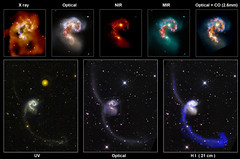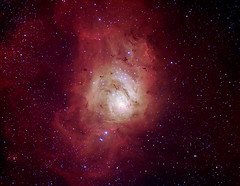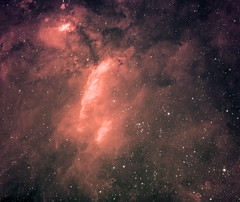
This is the object we observed at the Anglo-Australian Telescope as part of the “Stargazing Live” events at Siding Spring Observatory (NSW, Australia).
We used the APOGEE camera at the AAT Cassegrain focus and took some short exposures in several broad-band filters (B, V, R and I).
The planetary nebular NGC 5189 is located in the constellation of Musca (“The Fly”), near the South Celestial Pole.
The distance to NGC 5189 is around 1780 light-years from Earth, as measured in 2008.
It shows one of the more remarkable complex morphologies among all the known planetary nebulae, with many structures at different scales, indicating that the progenitor star experienced multiple outbursts.
Each outburst had different velocities, inducing shock-waves in the surrounding gas.
The central star is classified as Wolf-Rayet-type [WR] because it is very hot, it shows intense features of helium, carbon and oxygen, and it has very high stellar winds.
The most massive stars undergo the Wolf-Rayet (WR) phase before exploding as supernova, but the central stars of ~10% of planetary nebula also show Wolf-Rayet-type features.
The Wolf-Rayet-type stars in planetary nebulae are much older objects than the “standard” WR stars, as they descend from evolved low-mass stars and not from high-mass stars.
That is why Wolf-Rayet-type stars in planetary nebula are named [WR].
Wolf-Rayet-type stars are closely related to white dwarf stars.
The central Wolf-Rayet-type star in NGC 5189 is a very rare, low-mass (about the mass of the Sun) WO (oxygen-rich) star. Its temperature is 165 000 K and its stellar wind moves at 2500 km/s.
The Wolf-Rayet-type star in NGC 5189 has a companion star of around 0.8 times the mass of our Sun. It needs 4 days to complete an orbit around the [WR] star, as discovered in 2015.
The complex morphology in NGC 5189 seems to be consequence of the interaction between the progenitor of the Wolf-Rayet-type star and its companion star.
In the AAT image, the green color is coming from glowing nitrogen and hydrogen, the blue color from glowing oxygen. The red color is coming from the stellar emission









